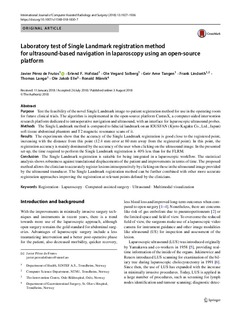| dc.contributor.author | Perez de Frutos, Javier | |
| dc.contributor.author | Hofstad, Erlend Fagertun | |
| dc.contributor.author | Solberg, Ole Vegard | |
| dc.contributor.author | Tangen, Geir Arne | |
| dc.contributor.author | Lindseth, Frank | |
| dc.contributor.author | Langø, Thomas | |
| dc.contributor.author | Elle, Ole Jacob | |
| dc.contributor.author | Mårvik, Ronald | |
| dc.date.accessioned | 2019-02-22T11:54:33Z | |
| dc.date.available | 2019-02-22T11:54:33Z | |
| dc.date.created | 2018-10-03T11:46:46Z | |
| dc.date.issued | 2018 | |
| dc.identifier.citation | International Journal of Computer Assisted Radiology and Surgery. 2018, 1-10. | nb_NO |
| dc.identifier.issn | 1861-6410 | |
| dc.identifier.uri | http://hdl.handle.net/11250/2587025 | |
| dc.description.abstract | Purpose
Test the feasibility of the novel Single Landmark image-to-patient registration method for use in the operating room for future clinical trials. The algorithm is implemented in the open-source platform CustusX, a computer-aided intervention research platform dedicated to intraoperative navigation and ultrasound, with an interface for laparoscopic ultrasound probes.
Methods
The Single Landmark method is compared to fiducial landmark on an IOUSFAN (Kyoto Kagaku Co., Ltd., Japan) soft tissue abdominal phantom and T2 magnetic resonance scans of it.
Results
The experiments show that the accuracy of the Single Landmark registration is good close to the registered point, increasing with the distance from this point (12.4 mm error at 60 mm away from the registered point). In this point, the registration accuracy is mainly dominated by the accuracy of the user when clicking on the ultrasound image. In the presented set-up, the time required to perform the Single Landmark registration is 40% less than for the FLRM.
Conclusion
The Single Landmark registration is suitable for being integrated in a laparoscopic workflow. The statistical analysis shows robustness against translational displacements of the patient and improvements in terms of time. The proposed method allows the clinician to accurately register lesions intraoperatively by clicking on these in the ultrasound image provided by the ultrasound transducer. The Single Landmark registration method can be further combined with other more accurate registration approaches improving the registration at relevant points defined by the clinicians. | nb_NO |
| dc.language.iso | eng | nb_NO |
| dc.publisher | Springer Verlag | nb_NO |
| dc.rights | Navngivelse 4.0 Internasjonal | * |
| dc.rights.uri | http://creativecommons.org/licenses/by/4.0/deed.no | * |
| dc.title | Laboratory test of Single Landmark registration method for ultrasound-based navigation in laparoscopy using an open-source platform | nb_NO |
| dc.type | Journal article | nb_NO |
| dc.type | Peer reviewed | nb_NO |
| dc.description.version | publishedVersion | nb_NO |
| dc.source.pagenumber | 1-10 | nb_NO |
| dc.source.volume | 13 | nb_NO |
| dc.source.journal | International Journal of Computer Assisted Radiology and Surgery | nb_NO |
| dc.source.issue | 12 | nb_NO |
| dc.identifier.doi | 10.1007/s11548-018-1830-7 | |
| dc.identifier.cristin | 1617535 | |
| dc.description.localcode | © The Author(s) 2018. This article is distributed under the terms of the Creative Commons Attribution 4.0 International License (http://creativecommons.org/licenses/by/4.0/) | nb_NO |
| cristin.unitcode | 194,63,10,0 | |
| cristin.unitname | Institutt for datateknologi og informatikk | |
| cristin.ispublished | true | |
| cristin.fulltext | original | |
| cristin.qualitycode | 1 | |

